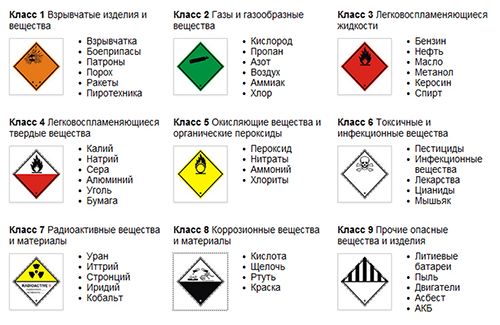Dangerous goods

At the initiative of the UNIn Geneva on September 30 , 1957 , it was createdADR (Accord européen relatif au transport international des marchandises dangereuses par route) European Agreement on the International Carriage of Dangerous Goods by Road, it came into force only on January 29, 1968, It operates on the territory of all EU countries, as well as in Kazakhstan, Azerbaijan, Morocco.
In Russia , a similar one is calledADR.
In addition to ADRtransportation of dangerous goodsIt is also regulated in accordance with the Temporary Instruction "On the Transportation of Dangerous Goods by road" of the Ministry of Communications.
In addition to this agreement, the following contracts for the carriage of dangerous goods are valid in Europe:
IMDG CODE (International Maritime Dangerous Goods Code) is the International Maritime Dangerous Goods Code (RID Code).
ICAO-TI (Technical Instructions for The Safe Transport ofDangerous Goodsby AIR) - Instructions for the carriage of dangerous goods by air, ICAO document 9284.
RID (International Regulations Concerning the Carriage of Dangerous Goods by Rail) - contract for the carriage of dangerous goods by rail.
Dangerous goods are divided into classes and subclasses, according to GOST 19433-88 and MK RID (International Code for the Carriage of Dangerous Goods by Sea). Their classification (assignment to a class, subclass, category and group) is made depending on the type of hazard. Types of hazards are classified according to the following criteria. Explosion hazard, Flammability, Toxicity (toxicity), Causticity (corrosion), Radioactivity, Oxidation (properties conducive to gorenje)
Hazard classes according to ADR classification
Dangerous cargo packaging
According to ADR, all dangerous goods must have a certain packing group. The packing group characterizes the degree of danger of the transported cargo. They are divided into three groups:
I - verydangerous cargo.
II is just dangerous cargo.
III - slightly dangerous cargo.
A Class 3 hazard feature is the ability to evaporate. Closed packages eliminate the formation and leakage of vapors. U 3-goThere can be one main hazard and a maximum of 2 additional hazards of the class.
Class 1. The main danger.
Class 2. The main danger + toxicity.
Class 3. Main danger + corrosion.
Class 4. The main danger + toxicity + corrosion.
Class 4.1 - packing group - II or III. Approximately 5% of these substances have an additional danger - thermal instability - the possibility of explosion (sulfur, cellulose).
Class 4.2 - packing group - I,II,III.
Class 4.3 - packing group - I,II,III.
Class 5.1 - packing group - I,II,III (mineral fertilizers, hydrogen peroxide).
Class 5.2 - has no packaging groups (raw materials chemical.factories).
Class 6.1 - packing groups - I,II, III. It has many additional hazards (prussic acid, arsenic, substances containing mercury, etc.).
Class 6.2 - has no packing groups.
Class 8 - groups of packages - I,II,III. It has many additional dangers.
Class 9 - packing groups - II,III. (asbestos dust is a carcinogen, substances during combustion of which dioxides are released, also carcinogens, do not decompose for 20 years).Gorenje
The peculiarity of Class 2 is that it does not have a major hazard and does not have groups of packages. It has the following special dangerous properties and their special designations:
A - suffocating -create a shortage of oxygen for breathing in closed rooms (inert gases).
O - oxidizing, that is, contributing to gorenje (oxygen).
F - flammability (propane).
T - poisonous.
Then two or more dangerous properties at the same time.
TF - toxic + flammable.
TC - toxic + caustic (corrosive).
TO - toxic + oxidizing.
TFC - toxic + flammable + caustic.
TOC - toxic + oxidizing (promote gorenje) + caustic (corrosive).
The packing group is not assigned for the following classes:
- 1. Explosives and articles
- 2. Gases
- 4.1 Flammable solids, self-reactive substances and solid desensitized explosives - for solid desensitized explosives
- 5.2 Organic peroxides
- 6.2 Infectious substances
- 7 Radioactive materials
TYPES OF PACKAGES AND THEIR LABELING
Dangerous cargo packaging is chosen by the shipper. Double packaging is used non-removable. If the package can be disassembled, then it is a combined package. IBC (Intermediate Bulk) is often usedContainer) — medium-capacity container up to 3000 liters. Such containers are considered packages. It is necessary to check the marking of the cargo. A danger sign is required. It is a rhombus with a rib length of no more than 100 mm. The location of all hazard signs on one side of the package is mandatory.
The reliability of the package is indicated by the Latin letters X, Y, Z. It is necessary to compare the packaging group and the reliability of the package.
- X is very reliable. Packing groups I, II, III.
- Y is just reliable. Packing groups II and III.
- Z - satisfactory reliability. Packing group only III.
- Views: 38981
- Government Resolution No. 778 dated 07/06/2018
- Which goods are declared as one product
- Government Resolution No. 2240 dated 07.12.2022
- What is required for DS according to TR CU 009/2011
- What is required for CC or DS according to TR CU 004/2011
- What is required for CC or DS according to TR CU 020/2011
- Customs control of the value of goods

























